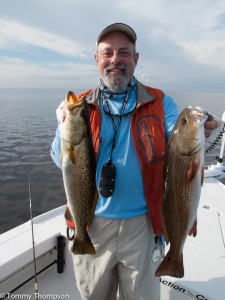How do successful anglers find bait and the predators that prey upon it?
Anglers of all skill levels sometimes have trouble spotting bait, a critical element in the “fish-catching” equation. Here’s a hint of what to look for on Florida’s Big Bend:

Calm, still waters like we often have on fall days, make it easy to spot jumping or schooling mullet. And when it’s calm, even small schools of glass minnows (bay anchovies) are easy to spot. Wheeling and diving gulls and terns also point to predators attacking baitfish schools (Remember that pelicans usually dive over whole, live bait fish and that smaller birds are the ones that scavenge near schools of striking predators.). Pinfish are easy to spot with the sun at your back, and you’ll always find them this time of year near pods of rock grass (kelp) on the shallow close-to-shore flats. Shrimp and crabs are not as easy to see, but you can expect to find crabs near and inside of rocky structure and shrimp along the edges of white sand patches—that’s why trout and reds hunt there. In all cases, when the wind’s a-howling or there’s a chop on the water’s surface, expect bait to be harder to see. That’s when pro anglers get out the binoculars and inspect the horizon and shoreline carefully, looking for bait signs. But don’t take anyone else’s word as to exactly where today’s bait will be. It likely will be somewhere else!

